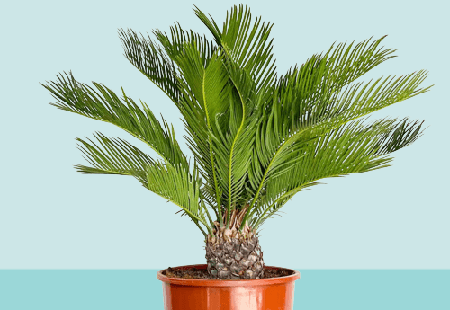Japanese Sago Palm Characteristics, The Japanese palm cycas has a great need for prolonged sun and constant air currents. It develops much faster outdoors than indoors. The slow growth characteristic is only related to the elongation of the main trunk. But this is not a problem. Because its leaves grow in all directions, making it both tall and very space-consuming.
Its homeland is Japan and the Pacific Islands. They are evergreen ornamental plants of tropical or semi-tropical regions. They grow up to 2 m tall. Evergreen, leaves are large, hard, feather-shaped, divided, in bunches at the top of the stem and perennial. The crown occupies a maximum of 2.5 m in diameter. It should be protected from frosts. They like places with high relative humidity. It grows well in partial shade and it is unfavorable to stay in direct sun. Minimum temperature is +16 °C. They can be used in gardens, balconies, indoors and terraces.

Cycas trees have separate males and females. If there is no male tree for seed formation, the female tree does not produce seeds. When they bloom, when the flowers of the female tree bloom, the pollen flowers of the male tree are plucked and taken, and the female flowers are shaken on top of them so that the dust reaches the necessary places and seed formation is possible.
Caring for Cycas revoluta, or the Sago Palm, involves attention to several key aspects, including light, water, soil, temperature, and general maintenance. Here’s a more detailed guide:
- Light:
- Provide bright, indirect light. The Sago Palm can tolerate some direct sunlight, especially in the morning, but prolonged exposure to intense sunlight can lead to leaf burn.
- Indoors, place the plant near a window where it can receive filtered sunlight.
- Watering:
- Allow the top inch or two of the soil to dry out between waterings. Sago Palms are sensitive to overwatering, so avoid keeping the soil consistently wet.
- Water thoroughly when you do water, and ensure that the pot has drainage holes to prevent water from pooling at the roots.
- Soil:
- Use a well-draining potting mix, preferably one designed for cacti or succulents. This helps prevent waterlogging, which can lead to root rot.
- Temperature and Humidity:
- Sago Palms prefer warm temperatures and can tolerate a range from 15 to 110°F (-9 to 43°C). However, they are not frost-tolerant.
- Maintain moderate humidity levels. If your indoor environment is very dry, occasional misting or placing a tray with water and pebbles near the plant can help increase humidity.
- Fertilizing:
- Fertilize with a balanced, slow-release fertilizer during the growing season (spring and summer). Reduce or stop fertilizing during the fall and winter when the plant is not actively growing.
- Pruning:
- Trim brown or yellowed fronds with clean, sharp pruning shears. This helps maintain the plant’s appearance and redirects energy to healthier growth.
- Pests and Diseases:
- Keep an eye out for pests like scale insects and mealybugs. If you notice any, treat them promptly with insecticidal soap or neem oil.
- Ensure good air circulation around the plant to prevent fungal issues. Well-draining soil also helps prevent root rot.
- Potting:
- Repot the Sago Palm every 2-3 years or when it outgrows its container. Use fresh potting mix and choose a container with drainage holes.
- Caution:
- Remember that all parts of the Sago Palm are toxic if ingested, so take precautions to keep it away from children and pets.
Observing your plant and adjusting care based on its specific needs and responses is crucial. Cycas revoluta is relatively hardy, but proper care enhances its health and appearance.
